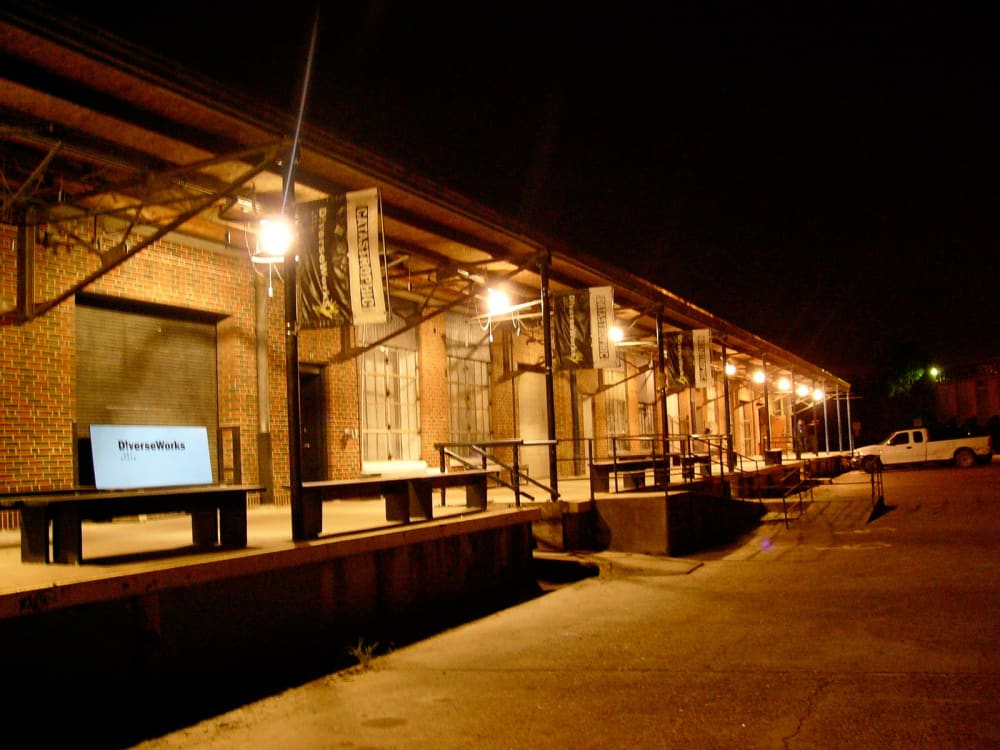$22 million still needed
A new art nexus: The implications of Houston's (proposed) Main Street artscomplex
 The IAC's future neighborhood.
The IAC's future neighborhood. Emily Todd, board member of the Independent Arts Collaborative.Photo by George D. Hixson
Emily Todd, board member of the Independent Arts Collaborative.Photo by George D. Hixson The current DiverseWorks location north of downtown.
The current DiverseWorks location north of downtown.
In what could easily be the culture coup of the decade, a handful of talent-rich non-profits are joining forces in an attempt to create the Independent Arts Collaborative, a central campus in the heart of Midtown for such organizations as Catastrophic Theatre, DiverseWorks, Main Street Theater and Suchu Dance.
"It's going to be fantastic," IAC board member and former Menil Collection deputy director Emily Todd tells CultureMap.
Todd paints a portrait of a booming cultural district surrounding the Ensemble/HCC light rail station, anchored by the future IAC building at 3400 Main Street. The area is already the focus of cultural and commercial investment with such stalwarts as the Ensemble Theatre, Isabella Courts and Continental Club, along with eateries like Julia's, Natachee's and Tacos A Go-Go.
What unifies all of the participating art groups is their current dilemma of renting exhibition or performance spaces. The groups also occupy buildings that aren't purpose built, which presents difficulties in providing optimal programming. Consider DiverseWorks' warehouse digs, where the shear sound of summertime air conditioning overshadows performances.
The IAC's arrival will represent the end of an era in which such fringe organizations have been relegated to the outskirts of downtown and outlying neighborhoods.
"They all have some limitations that are created by the fact that they don't own these spaces and the spaces are not made for art — that's what makes these organizations so wonderful, that they've had the creativity to overcome that in the past," Todd says.
Logistically, IAC will allow the organizations to collocate, share marketing, programming and a general back office. Coordinated education and outreach programs will also be a benefit. This synergy will allow cohesive, action-packed season-wide programming. "People could just come by and see what's going on at this cultural multiplex," Todd says.
Behind doors, fresh concepts will flow freely, allowing for all the more dynamic programs. "We'll experience that thing that Houstonians never experience because of our sprawling city: Sharing ideas," says Louie Saletan, who operates the Barnevelder Movement/Arts Complex, where Suchu Dance and other organizations hold classes and performances.
The IAC's arrival will represent the end of an era in which such fringe organizations have been relegated to the outskirts of downtown and outlying neighborhoods. Now, they'll be centered between downtown's Theater District and the Museum District to the south.
Talks between participating organizations began almost six years ago.
"We didn't consciously say, 'Let's build a facility,' but we could see the writing on the wall in that we could only get so far in our current circumstances in areas of town that only certain people would venture out to," Saletan says. "We weren't able to leverage the investment of human talent, time and energy into getting a good turnout. And then we realized how much we all have in common."
According to Saletan and Todd, establishing that camaraderie was the easy part. It was locating the ideal plot of land that would take so many years for the IAC to take root. The city-owned lot at 3400 Main became increasingly appealing, so the team conducted an economic analysis on the IAC's impact on the surrounding streets. When a positive growth in sales and mixed beverage taxes was identified, a proposal was presented to the city.
Houston City Council responded with a $6 million tax reimbursement deal. Once the IAC raises funds and the participants occupy the new building, an incremental tax over 10 to 15 years will reimburse the non-profit. But first, the IAC and its cultural scion-studded board must raise the $22 million necessary to build its sparkling midtown structure.
"The key thing is to make sure the facility could run without ongoing philanthropic support," Saletan says. "We're going to be here for the long haul — 30, 50 years, maybe longer. We want to recoup this investment." Once the building is repaid, it will be transferred to the city and operated by the new Houston First organization.
Beside the arts complex will be a set of new buildings by developer Bob Schultz on the 3500 and 3600 blocks of Main, mixing retail, residential and office space. Schultz's Midtown pedigree includes 3600 Main and four businesses at 3700 Main.
The IAC has now made the $250,000 down payment on the $2.5 million property, and will finance the rest with a loan from the International Bank of Commerce. Serving as loan guarantor is Ensemble/HCC Partners, which is partially managed by Schultz, and holds two neighboring blocks.
An executive director search and international architectural competition are already in the works.
"We'll have it better mapped out at the end of the summer," Todd says.
"When Renzo Piano did the Menil, he wasn't really known," she adds, hinting at the possibility of a building that could be an attraction within itself. Nothing is cast in stone, but a 300-seat theater and flexible exhibition and performance spaces will likely be part of the 90,000-square-foot blueprint.
More than anything, the IAC wants to be a point of civic pride.
"What's so magical is that a wide array of people want it there — Midtown residents and business owners, the Ensemble Theatre, politicians, the light rail authorities. It had so many synergies," Saletan says.
Echoes Todd, "I just think it's thrilling that this is happening on our Main Street. It's just such a win-win for the city, our artists and the cultural community at large. People who think that Houston doesn't have anything to offer will easily be able to come and see. For a lot of people, it will be new territory."





